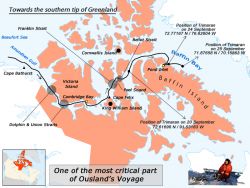The most perilous part of the voyage is over
Published on 25.09.2010 - The Northern Passage 2010
Børge Ousland is almost through with the most perilous part of his voyage. He still has to face icebergs coming from Greenland's glaciers and the crossing of a raging ocean.
Three years in early 20st century, one month in 2010...
The circumnavigation of the trimaran Northern Passage will stay in polar memory as the first sailing vessel (together with russian monohull yacht Peter 1er of which we are going to talk later in another article) that has ever sailed through both the Northeast and Northwest passages in one short arctic summer.
This feat is more important than one could normally think. Because this expedition can be compared and brought together with the first northwest passage achieved by Roald Amundsen about a century ago. What happened at that time? The famous Norwegian explorer took no less than three years (1903-1906) to complete the traverse east-west, this is from the west coast of Greenland to the Beauffort Sea. The voyage which took three years to achieve in the early 20st century has lasted this summer no more than one month !
Of course, the conditions of these two expeditions were not at all the same. Amundsen wanted not only to discover a searoute to the west and to the Pacific Ocean through the Arctic Ocean -in other words connecting the Atlantic and Pacific Oceans- but he wanted also to be a scientific expedition, focusing the attention of his researchers on board on meteorological and magnetic observations. That's why he decided to winter twice in the Canadian Arctic Archipelago. Whereas Borge was seeking for a world premiere and wanted to succeed to sail through both passages in one time and one season.
"This shows how dramatic and how fast these changes are happening..."
Nevertheless hundred years have drastically changed the landscapes of the Arctic. Ousland, on 24 September: "It is, unfortunately, the dramatic changes in Arctic sea ice conditions in recent years that have made this trip possible. On the time of Roald Amundsen it took five to six years to complete the same distance, due to the extremely difficult and demanding ice conditions. Now we have proven that it is possible to make the voyage in a 31-foot fibreglass sailing boat, equipped with a 10 horsepower outboard motor for emergencies. This shows how dramatic and how fast these changes are happening. The changes that we are witnessing will influence climate on a global scale, in addition to the whole range of animal life in the Arctic -especially seals and polar bears, whose lives are dependent on the sea ice. It is our hope that our voyage will be seen as a strong, visible symbol of the scale and the speed of these changes...."
These days, trimaran Northern Passage is undertaking the third part of her voyage, sailing back to Oslo via the Atlantic Ocean. The Frenchman Eric Brossier left his companions at Pond Inlet, being replaced by Trygve Rushfeldt, a long time multi-hull sailor from Norway. But as Ousland says in his last update, "the voyage ain't hardly over yet..."
See here a quite interesting site about the history of the discovering and exploring of he Northwest Passage.











